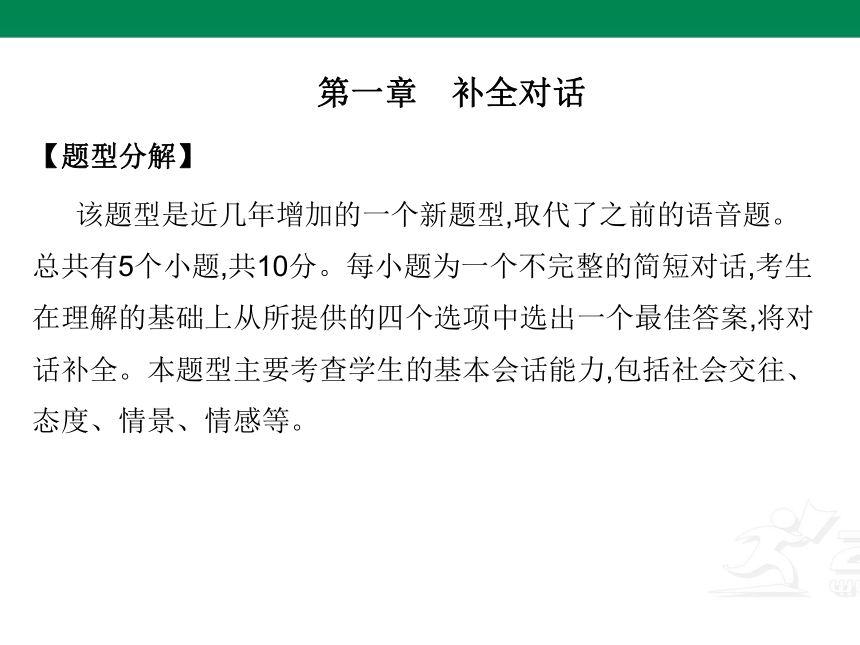(
课件网) 第一章 补全对话 【题型分解】 该题型是近几年增加的一个新题型,取代了之前的语音题。总共有5个小题,共10分。每小题为一个不完整的简短对话,考生在理解的基础上从所提供的四个选项中选出一个最佳答案,将对话补全。本题型主要考查学生的基本会话能力,包括社会交往、态度、情景、情感等。 【方法指导】 1.熟悉句型结构,增强理解能力; 2.熟悉中、英两种文化差异,掌握两个不同民族的交际习惯; 3.广泛阅读,积累各种情景中交际应酬的用语,从而提高交际能力。 ( )1.—Go for a picnic this weekend,will you — .I love getting close to nature. A.I couldn’t agree more B.I’m afraid not C.I believe not D.I don’t think so 【解题思路】 从第二句我们得知,答者“喜欢亲近大自然”,那当然是想去了。I couldn’t agree more是表示非常赞成别人说的话,意思是“我非常赞同”。因此答案是A。 ( )2.—Sir,how do you like your steak cooked — . A.Well done,please B.Wonderful C.It’s delicious D.Three,please 【解题思路】 从第一句我们知道这是餐厅的服务生和顾客之间的对话。服务生问的是“先生,你想要你的牛排怎么做 ”,回答应该是“全熟”或“几成熟”等,所以答案应选A。 ( )3.—Do you mind my taking this seat — . A.Yes,sit down,please B.No,of course not C.Yes,take it,please D.No,you can’t take it 【解题思路】 注意mind这个单词,如用Yes回答则表示“介意”,用No回答才是表示“不介意”。要表示“不介意”才可以“坐”,所以答案选B。 ( )4.—Would you like some more soup — .It’s delicious,but I have had enough. A.Yes,please B.No,thank you C.Nothing more D.I’d like some 【解题思路】 根据所给对话我们知道,问的是“你还要不要汤”,回答是“味道很好,但我喝够了”,那也就是不要了,所以选B。 ( )5.—You can teach me English and I can teach you Chinese. — . A.The same to you B.What a pity C.Me,too D.That’s a deal 【解题思路】 第一句的意思为“你可以教我英语,我可以教你中文”,选项A的意思是“你也是一样”,B的意思是“真可惜”,C的意思是“我也是”,都与题意不符合。选项D的意思为“成交”,说明答者赞同说话者的提议,所以该题选D。 ( )6.—How’s everything going —Fine,thanks.How are you doing — . A.I’m 16 B.Yes,it’s good C.Oh,not too bad D.See you then 【解题思路】 准确理解How are you doing 的意思,是用来询问对方近来如何,所以答案选C。 ( )7.— .Can you tell me the way to the railway station —It’s not far from here.Go along this street.Turn right at the second crossing.The railway station is on your left. —Thank you very much. A.Hello B.Good afternoon C.Pardon D.Excuse me 【解题思路】 是问路时的对话。我们在问路时,往往会说“你好!请问…… ”,而英语的表达是Excuse me。因此答案选D。 ( )8.—How do you like the book — . A.I like it very much B.I don’t like it C.I think it’s interesting D.I don’t know 【解题思路】 从第一句我们可以看出,说话人是在询问对方对这本书的评价及看法,而不是真的在问对方是否喜欢这本书,因此答案选C。 ( )9.—Can you lend me your car,Jack —Sorry.My car broke down on my way to work.It’s being repaired. — . A.Thank you B.Thanks a lot C.It’s OK D.Thank you all the same 【解题思路】 当得到别 ... ...

